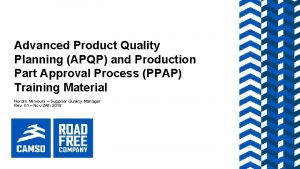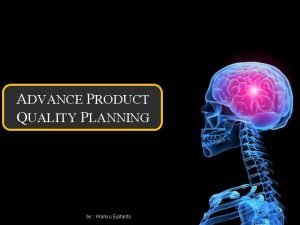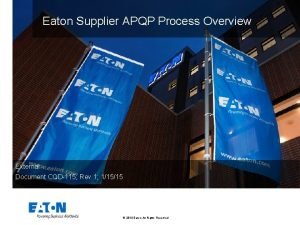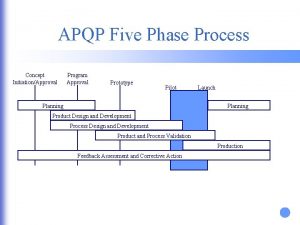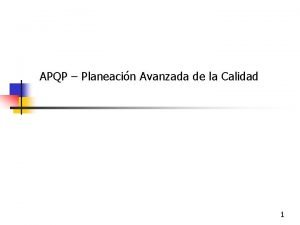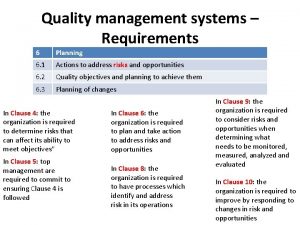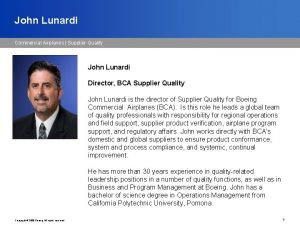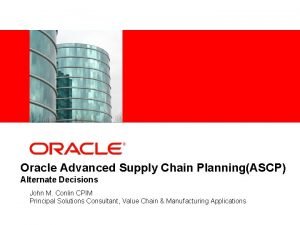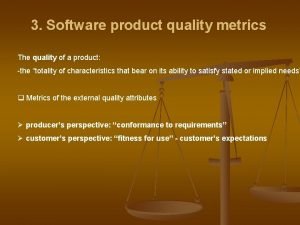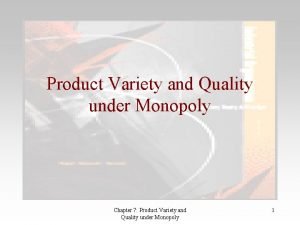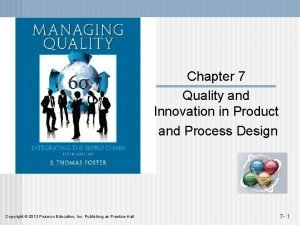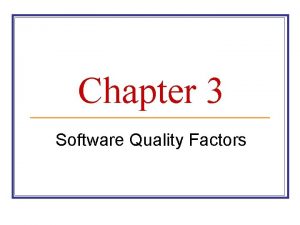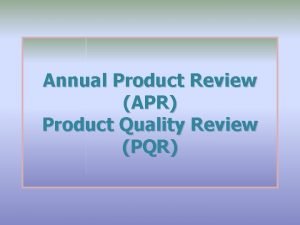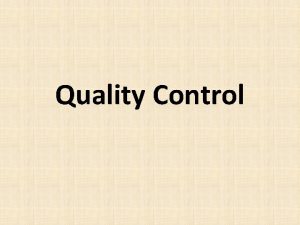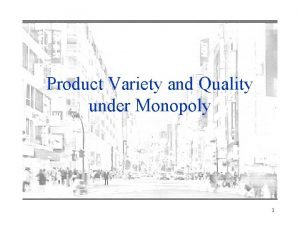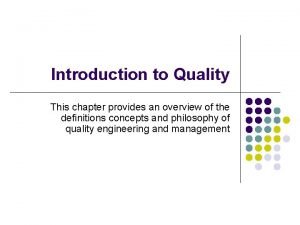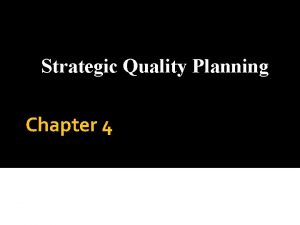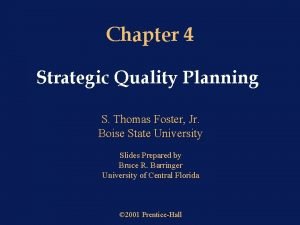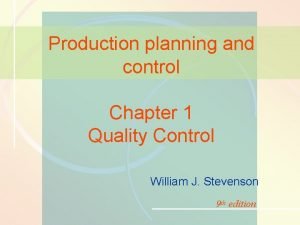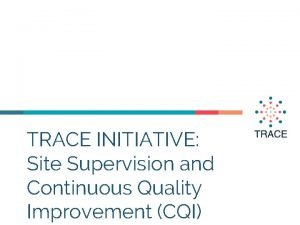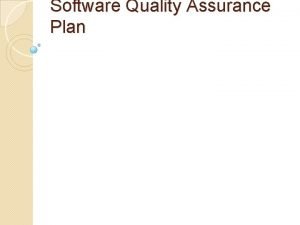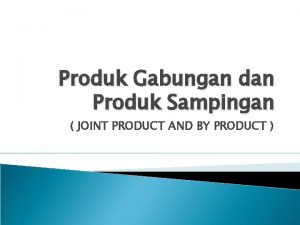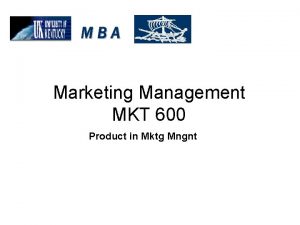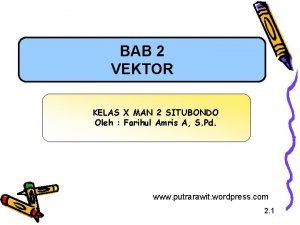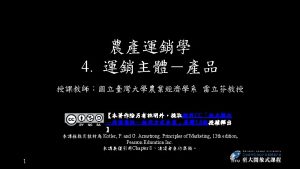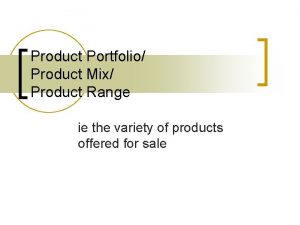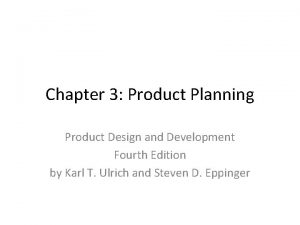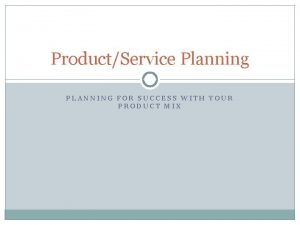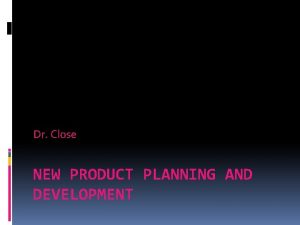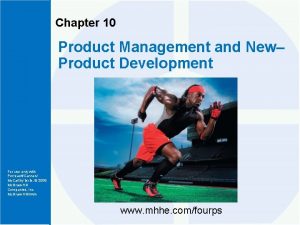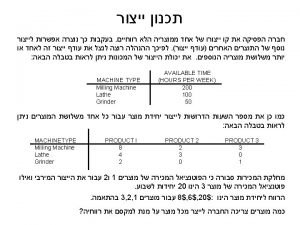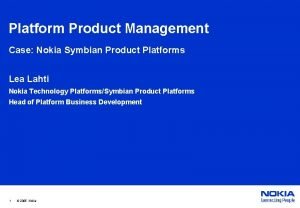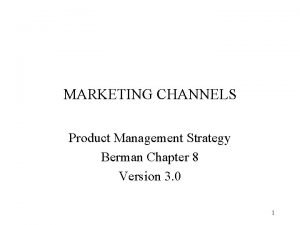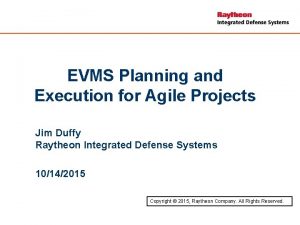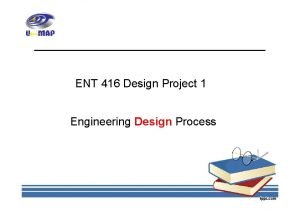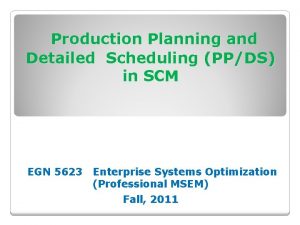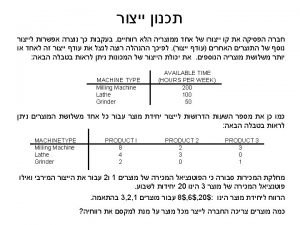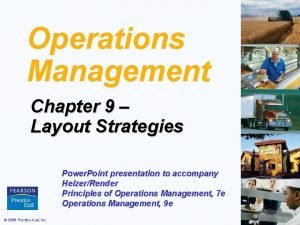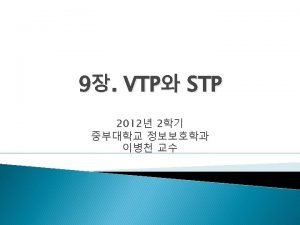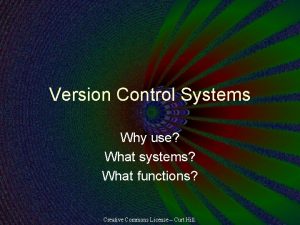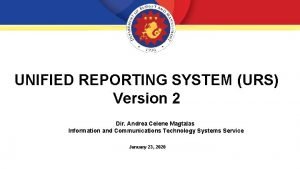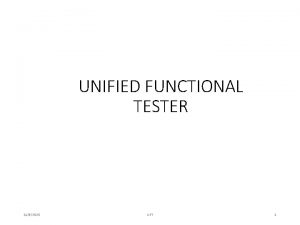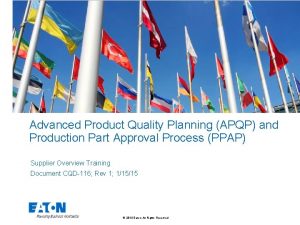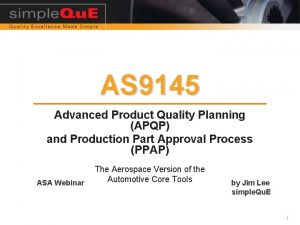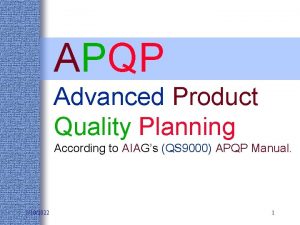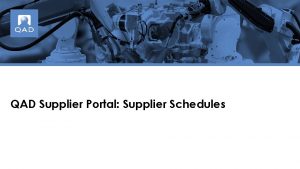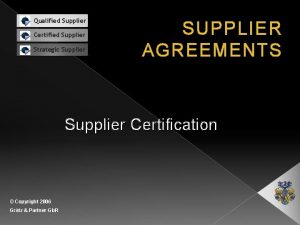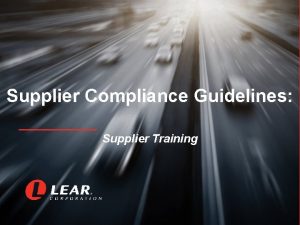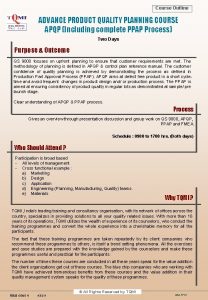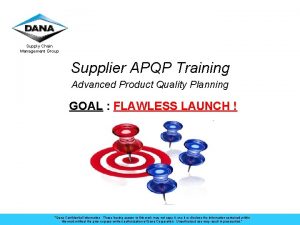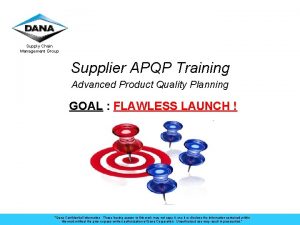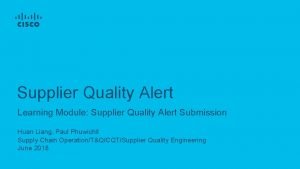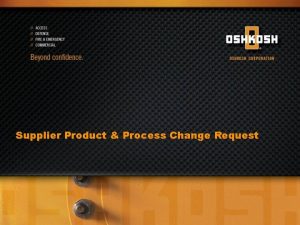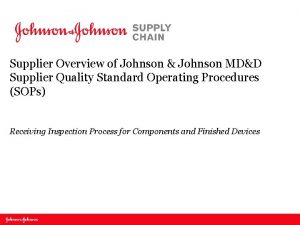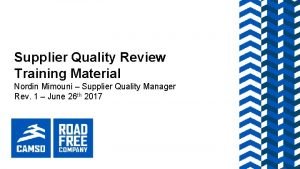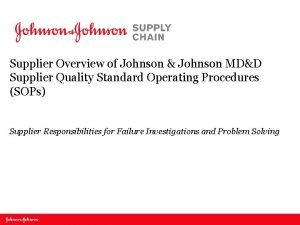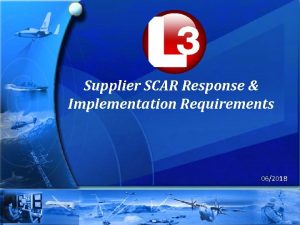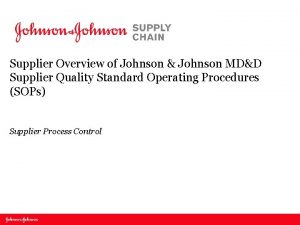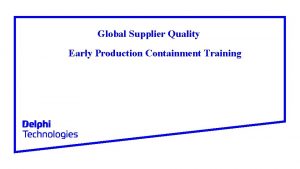APQP Advanced Product Quality Planning Supplier Version Supplier















































































- Slides: 79

APQP (Advanced Product Quality Planning) Supplier Version Supplier Technical Assistance Business Office

Training Purpose • • It is intended to be an overview of the APQP process. It is not intended to be a detailed training instruction in the use of the APQP Assessment. • Basic Industry Tools (e. g. FMEA & PPAP) are unchanged. However, the format of the APQP assessment has changed. • • Important to focus on the tools not just the format Where to find additional information is given at the end of this presentation

Contents • Background ü APQP - Key Features when considering GPDS ü JLR & Supply Base Integration ü Process overview ü PMST: Key Deliverables

Contents (continued) • Reporting Process Overview ü APQP Assessment ü APQP Reporting • Priority / High Impact Supplier Engagement Overview ü Priority / High Impact Supplier Selection ü Team Make up ü Supplier Evaluations Note: The terms Priority supplier & High Impact supplier are interchangeable.

APQP – Key Features when considering GPDS • Emphasis on “Front-End Loading” of a programme to support earlier activities • Failure Mode Avoidance through Compatibility before Completion • Powertrain (PT), Under Body (UN) & Upper Body (UP) start at different points • Higher reliance on Virtual Engineering, Virtual Builds • Virtual Prove-Out = early & cheap: before FDJ • Physical Prove-Out = late & expensive… • Synchronised Compatibility Check at FDJ • Single Point of Release • VP Build to verify total vehicle Specs. • Shorter launch period

JLR & Supply Base Integration PMST Compatibility verification with the supplier’s manufacturing site: Product Design Process Design an ed Pl cut e ex an Pl on e? tim e re Ag m O om on Pr in c ip le s A FM ck Ki ff C Ongoing Communication of requirements, changes, effects, issues, solutions, re-planning = PMST Core Business Supplemented by STA Site activities ~ (Priority Supplier Manufacturing sites)

APQP: Approach • Suppliers are required to use Advanced Product Quality Planning & Production Part Approval Process (TS 16949 & Customer Specifics) • From Sourcing to Launch APQP is the prime method of planning & communication between JLR & Supplier: Status is critical to JLR • Some Suppliers will be designated Priority Suppliers. Degree of engagement will be determined by > Supplier Manufacturing Site Capability > Part Criticality • • Designation will be reviewed during the course of the programme Jaguar Land Rover multifunctional teams will evaluate Priority suppliers a minimum of four (4) times > PMST Deep Dive Confirmation

APQP – PMST Additional emphasis • STA Role: Confirming programme viability at each Milestone based upon Supplier Readiness • STA’s involvement is critical in Failure Mode detection & countermeasure development = compatibility of Product Design & Process Design (Feasibility) • Facilitated by: • Formalised Cross-functional Team Engagement • Early Supplier Manufacturing involvement

APQP Process Overview

APQP Process Overview: Team Consensus of Status

APQP Process Overview

APQP Process Overview

APQP Process Overview

Principles of APQP Priority Supplier Engagement 1. Supplier launch success is a cross-functional, shared responsibility – PD, STA, Buyers are core team members (Other JLR team members, e. g. MP&L and AME can be called upon as and when necessary) 2. JLR cross-functional teams will work proactively with the highest leverage suppliers on a programme 3. Supplier engagement will begin early in a programme – immediately after sourcing

Principles of APQP Priority Supplier Engagement 4. JLR cross functional teams (PMST) will review Priority Suppliers a minimum of four (4) times (PMST to decide if all reviews need to be at the Supplier manufacturing site) 5. The teams will provide the supplier with a single JLR voice on key launch matters 6. Underlying APQP and PPAP processes and roles & responsibilities will remain the same 7. Team engagement will continue until the supplier has successfully completed all PPAP requirements and fully met all program ramp-up volumes

APQP Supplier Engagement – Priority Sites • A programme’s suppliers are defined as “Priority” or “Non. Priority. ” • Priority suppliers have parts that present major risks to the launch (site, part, or programme risk). • The list is reviewed at decision points in the programme • Early in the programme the focus has to be on suppliers where enhanced Failure Mode Avoidance effort is critical • Suppliers affected by late change should join the Priority list The APQP Supplier Engagement Process will focus crossfunctional JLR resources on the Priority suppliers.

APQP Process Overview – 49 Key Deliverables Reporting will focus on measurable “Deliverables” that highlight APQP Element completion at a given programme milestone APQP Element 1. Lead Sourcing decision Pre APQP: Site STA objective is: If STA Approves Non-Q 1 Sourcing then there is a sound basis for viability. Buyer 2. Customer input requirements 3. Craftsmanship/ appearance approval report 4. DFMEA Due* <PTCC> Deliverables 1. Required Sourcing Agreement Signed <PA> 2. Required Supplier Commercial & Program Agreements Signed <FDJ> 3. All Production Tool Orders Issued to Suppliers <PA> 4. Final Mix, Maximum Weekly Volume Communicated and Agreed PD <PA> 5. Program Expectations Cascaded to Suppliers PD <TT> 6. AAR Approved <PP> 7. Color Changes Completed Supporting Color Harmony <PA> 8. DFMEA Completed <PA> 9. Special Characteristics Cascaded to Suppliers PD 5. Design/manufacturing reviews PD/STA <PP> 10. Quality Issues Closed and Effective 6. DVP&R material, performance test results PD <TT> 11. DV Testing Complete 7. Subcontractor APQP status STA *UP Timing Shown <FDJ> 12. Sub-supplier PPAP Timing Plan Completed <TT> 13. Sub-supplier PPAP Phase 1 (or equivalent) Completed <MP 1> 14. Sub-supplier PPAP Phase 3 (or equivalent) Completed

Reporting will focus on measurable “Deliverables” that highlight APQP Element completion at a given programme milestone APQP Element 8. 9. 10. 11. Facilities, Tools & Gauges Lead STA Due* <FDJ> Deliverables 15. Facility and Tooling Timing Plan Completed <TT> 16. Facilities/Tools/Gauges are at the Final Production Location <PTC> 17. Supplier’s OEE plan is Confirmed by Surrogate Data <PA> 18. Gauge Plan (Including Released Gauge Drawings) Completed <TT> 19. Supplier’s Demonstrated OEE (Phase 0) supports capacity requirements Prototype Control Plan PD <FDJ> 20. Prototype Build Control Plan Completed Prototype Build PD <FDJ> 21. All Prototype Tool Orders Issued to Suppliers <FDJ> 22. Prototype Parts Ordered <FDJ> 23. Prototype Parts Achieve 100% of Required Print Specs. <PSC> 24. Design Styling Confirmation <FDJ> 25. Design Release (WERS) Completed Drawings & Specifications PD 12. Engineering Change PD 13. Team Feasibility PD/STA <FDJ> 27. Design, Process, & Timing Feasibility Confirmation 14. Manufacturing Process Flow STA <PEC> 28. Final Process Flowchart Supports PPAP Phase 0 Event *UP Timing Shown <TT> 26. All JLR Engineering Changes Approved & Recognized by the Supplier

Reporting will focus on measurable “Deliverables” that highlight APQP Element completion at a given programme milestone APQP Element Lead Due* Deliverables 15. PFMEA STA/PD <VP> 29. Final PFMEA Completed with Linkages 16. Measurement System Analysis STA <TT> 30. Gauge R&R Results <= 10% per PPAP Ford Customer Specifics 17. Qualified Laboratory Documents STA <TT> 31. Supplier Internal & External Laboratory Compliance 18. Checking Aids STA <TT> 32. Checking Aids Compliant With Part Specifications 19. Pre-Launch Control Plan STA <PEC> 33. Pre-Launch Control Plan Completed with Linkages 20. Operator Instructions STA <PEC> 34. Operator Process Instructions Completed 21. Packaging Specifications MP&L <TT> 35. Packaging Approval Process Completed 22. Production Trial Run STA <TT> 36. PPAP Phase 0 (Including Sub-suppliers) Completed 23. Production Control Plan STA <TT> 37. Production Control Plan Complete with Linkages 24. Initial Process Capability STA <TT> 38. Initial Process Capability Results (Ppk >= 1. 67) *UP Timing Shown

Reporting will focus on measurable “Deliverables” that highlight APQP Element completion at a given programme milestone APQP Element Lead Due* Deliverables 25. Dimensional Results STA <TT> 39. 100% of Required Measured Points within Tolerance 26. PV Testing PD <TT> 40. PV Testing Complete 27. PSW STA/PD <TT> 41. PPAP Phase 1 Completed <PEC> 42. Demonstrate Compliance with RSMS <PP> 43. PPAP Phase 2 Completed <MP 1> 44. PPAP Phase 3 completed <MP 1> 45. Suppliers Demonstrated OEE Support Capacity Req. 28. Bulk Material Requirements STA <TT> 46. Bulk Materials Checklist Included in PPAP Submission 29. Sample Product STA <TT> 47. Sample Product Produced with JLR Identification 30. Master Sample STA <TT> 48. Master Sample Approved 31. Record of Compliance STA <TT> 49. JLR Specific Requirements Documented *UP Timing Shown

Supplier Sourcing Unit PTC Unit PA PTCC Supplier Sourcing Begins Priority Suppliers Selected Cross. Functional Teams Formed Team Kick-Off Meetings Begin PTC/ M 1 DJ M 1 PA FDJ VP PEC LR/ FEC TT PP MP 1 The APQP process begins once the suppliers are sourced. GPDS breaks the vehicle into Powertrain (PT), Underbody (UN), and Upperbody (UP). Sourcing completion is generically required by: PT: <PTCC> Resolve Open Issues UN: <PTCC> Evaluation UP: <PTCC> + 90 Days Evaluation #1 #2 Decisio n to Procee d to Run-At -Rate Evaluation #3 Update of APQP Assessment Evaluation #4

APQP Assessment Principles of Use: • Completed by all NTEI Suppliers • Submitted to JLR monthly after <PTCC> • Consolidated automatically to produce rolled-up supplier deliverables & readiness reports

APQP Assessment: Functionality: • The APQP Assessment uses Excel macros to function properly. • The user must always select ENABLE macros. Failure to enable the macros will result in loss of functionality. • The APQP assessment is designed for use with Excel 2003 and Excel 2007. • Using previous versions of Excel will result in a loss of functionality. • For further guidance please refer to the APQP User Guide

APQP Assessment: Meeting cadence Priority Suppliers: • Submit the APQP Assessment monthly as required by the STA programme team. • Site STA to review the APQP Assessment with the rest of the PMST prior to this monthly submission. Non Priority Suppliers: • Submit the APQP Assessment as per Priority Suppliers • Send copy of APQP Assessment to STA and PD engineers prior to submission to the JLR programme team

APQP Assessment -- Detail 2. Element Status Section Structure: 31 The Element Status section of the Assessment is structured in a hierarchy that includes: APQP Elements Team Business 49 Deliverabl es (minimum 1 per element) 215 Expectatio ns Qo. E Criteria -- APQP Elements -- Deliverables -- Expectations The suppliers will enter their specific status ratings in this section of the document against each programme milestone or build event.

APQP Assessment -- Detail The APQP Assessment contains 3 sections: 1) Header Section 2) Element Status Section 3) Summary Section

APQP Assessment -- Detail 1. Header Section The header section of the Assessment provides general information about part, supplier, team contacts, and key programme dates. There also selection boxes that indicate Priority/Non-Priority, GPDS Vehicle Partition (Powertrain – PT, Underbody – UN, Upperbody – UP), and PMT. These selection boxes are important because they are required for management reports, and they will display the proper rows to reflect differences in UP and UN timing, for example. Denotes Selection Box

APQP Assessment -- Detail 2. Element Status Section -- Definitions Element: One of the 31 unique requirements of the APQP and PPAP process

APQP Assessment -- Detail 2. Element Status Section – Deliverables are the metrics used to define the status (RED/YELLOW/GREEN/COMPLETE) of the individual 31 elements. There is at least one Deliverable for each element, but there can be multiple deliverables for each element. As noted previously, there a total of 49 Deliverables are intended to reflect, where possible, quantifiable evidence of element success or completion. Deliverables can reflect key in-process metrics like Cpk or OEE, for example.

APQP Assessment -- Detail 2. Element Status Section -- Deliverables All 49 Deliverables are required to be rated with every submission of the Assessment Against the program milestones, Deliverables will show two colour schemes: • Light Grey With No Box – Forecast Period (activity is not expected in this time period, but the supplier must enter a rating to show whether or not they forecast risk to the deliverable completion in the future. • Dark Grey With Black Box – Deliverable Start & End Points (activity is expected to begin and end between these milestones)

APQP Assessment -- Detail 2. Element Status Section -- Deliverables Example: This deliverable is rated GREEN in the Forecast period denoting there was no expected risk to completion by FDJ. The Deliverable Start & End point spans <PA> to <FDJ>. The <PA> milestone is rated GREEN, and the <FDJ> milestone is rated COMPLETE. Per GPDS convention, the Deliverable end point can only be rated RED (if not finished) or COMPLETE (if finished).

APQP Assessment -- Detail 2. Element Status Section -- Expectations are guidelines used to assist team members in the successful completion of the elements, and where applicable, help rate completion of the related deliverables. While expectations can be rated RED/YELLOW/GREEN/COMPLETE, they will not drive the element rating – only deliverables are rolled-up to drive element ratings. The ratings for expectations are intended only for internal use and communication. Expectations should be thought of as Quality of Event criteria

APQP Assessment -- Detail 2. Element Status Section -- Expectations Example: These Expectations were rated YELLOW at <PTC> and AA 1 showing a potential risk. By <FDJ>, the Expectation end points, they were rated COMPLETE. Note: Expectations are not used to drive Element status. There is no requirement to provide a Forecast rating for an Expectation.

APQP Assessment -- Detail 3. Summary Section This part of the Assessment is intended to summarise the element status for the entire document. There are 4 parts to the summary: 1. Current Milestone Deliverable Status 2. Forecast Milestone Deliverable Status 3. Phased PPAP Element Dates 4. Supplier Evaluation Summary (Priority sites only)

APQP Assessment -- Detail 3. Summary Section Current Milestone Deliverable Status: Indicates the status for only those elements with deliverables required to be completed by the currently assessed milestone. These fields are automatically generated based upon input in the Element Status. The one exception are the words for the Action Plan Summary – these must be manually entered and should be limited to the Key Escalation Issues, and not made up from a cut and paste of the Element status section.

APQP Assessment -- Detail 3. Summary Section Forecast Milestone Deliverable Summary: Indicates the status of remaining deliverables not yet required for completion at a given milestone. The majority of these fields are automatically generated based upon input in the Element Status. The Action Plan Summary fields must be manually entered. This provides a forward looking view of future deliverables for use by the team.

APQP Assessment -- Detail 3. Summary Section PPAP Element Dates: A summary of PPAP dates outline in the Element Status. The dates are automatically populated from the deliverables, while Build Support Plans must be manually entered Supplier Evaluation Summary: Required for Priority suppliers only. The team manually tracks planned and actual visit dates. The data is rolled up on Element Summary Report.

APQP: Summary of Deliverable Rating Criteria

Summary of Deliverable Rating Criteria Prior to Required Deliverable Completion Timing: Deliverables can be rated RED, YELLOW, GREEN, or COMPLETE At Required Deliverable Completion Timing: Deliverables must be rated either COMPLETE or RED. A deliverable must be tracked until it is complete After Required Deliverable Timing Completion Timing (Red items only): A deliverable will continue to be rated RED until it is COMPLETE. It will no longer required to be rated at subsequent milestones after it is COMPLETE.

Summary of Reporting Process • • APQP Assessments will be completed by every NTEI supplier and submitted to JLR on a monthly basis from <PTCC> to PPAP Completion For Priority suppliers, the cross-functional team shall achieve consensus on Deliverable ratings Programme Reports will be generated from the Assessments Key Escalation Issues and Actions must be explained in the Action Plan Summary – the audience includes Board Members

Priority Supplier Selection Unit PTC Unit PA PTCC Supplier Sourcing Begins Priority Suppliers Selected Cross. Functional Teams Formed Team Kick-Off Meetings Begin PTC/ M 1 DJ M 1 PA FDJ VP PEC LR/ FEC TT PP MP 1 Once sourcing is complete, the STA Programme Lead and the PD Programme Lead will work with the STA Site Managers & Engineers, and PD Programme Leaders & PMST Leaders to complete the Selection of “Priority” suppliers for the Resolve Open Issues programme. A specific risk model is used to guide the Priority Decisio n to suppliers. Evaluation Procee #1 #2 d to Run-At -Rate #3 Update of APQP Assessment #4

Priority Supplier Selection Process – Initial Model Supplier Selection process is led by program STA and PD and reviewed by Site STA. This process shall take place by the following: • Underbody: <PTCC> + 90 days • Upperbody: <PTC> Site Readiness OR Part Criticality OR Programme Induced Risk = Programme Priority Suppliers

Team Formation Unit PTC Unit PA PTCC Supplier Sourcing Begins Priority Suppliers Selected Cross. Functional Teams Formed Team Kick-Off Meetings Begin PTC/ M 1 DJ M 1 PA FDJ VP PEC LR/ FEC TT PP MP 1 The STA and PD Programme leads will notify the appropriate PD Engineers, Buyers, and STA Site Engineers, that their suppliers are designated as Priority for a given programme. This notification will include specific timing and reporting Resolve Open Issues requirements for the programme. Evaluation #1 Evaluation #2 Decisio n to Procee d to Run-At -Rate Evaluation #3 Update of APQP Assessment Evaluation #4

Team Member Responsibilities While there is a team lead at all times, each team member still has the responsibility between meetings to: • Resolve open concerns • Communicate with other team members as needed • Bring together other team members to close out concerns as necessary It is recognised that all team members will interface with the supplier regularly between Evaluations, and viability issues are raised immediately

Team Kick-Off Meetings Unit PTC Unit PA PTCC PTC/ M 1 DJ M 1 PA FDJ VP PEC LR/ FEC TT PP MP 1 Supplier Sourcing Begins Priority Suppliers Selected Cross. Functional Teams Formed Team Kick-Off Meetings Begin Prior to the Evaluations, the cross-functional JLR team members will meet with their supplier team to review programme expectations and begin the preparations for site visits. Resolve Open Issues This is called the “Kick-Off” meeting. Evaluation #1 On-Site Evaluation #2 Decisio n to Procee d to Run-At -Rate On-Site Evaluation #3 Update of APQP Assessment On-Site Evaluation #4

Team Kick-Off Meeting – Key Points Purpose: Introduce JLR and supplier team members • • JLR and supplier team agree on the required programme and process timing. Communicate team expectations in preparation for Evaluation #1. Ø Plan to exploit opportunities that on-site activity will give (e. g. surrogate process & design review) Timing: PT: Unit <PTC> -- <PTCC> UN: <PSC> - <PTCC>+90 Days UP: <PTCC> – <PTC/M 1 DJ> Note: Actual review timing will depend upon the specific needs of the component and program. Participants: Lead: PD Engineer Support: STA Site Engineer, Buyer Location: JLR facility, supplier facility, or teleconference (according to team preference). Meetings will typically last 2 – 3 hours.

Evaluation #1 Unit PTC Unit PA PTCC Supplier Sourcing Begins Priority Suppliers Selected PTC/ M 1 DJ M 1 PA FDJ PEC LR/ FEC TT PP MP 1 The cross-functional team’s first detailed review is called Evaluation #1 – Verification of Supplier Failure Mode Avoidance Strategy, Manufacturing Feasibility & Planning. Timing for this visit will depend on the section of the vehicle where the part resides – PT, UN, or UP Cross. Functional Teams Formed Team Kick-Off Meetings Begin VP Resolve Open Issues Evaluation #1 Evaluation #2 Decisio n to Procee d to Run-At -Rate Evaluation #3 Update of APQP Assessment Evaluation #4

Evaluation #1 – Key Points Purpose: • • Failure Mode Avoidance through detailed FMEA and Control Plan reviews: Feasibility & actions to resolve by FDJ Manufacturing Planning Capacity Planning Timing: PT: <PTCC> - <PTC/M 1 DJ> UN : <PTCC> - <PTC/M 1 DJ> UP : <PTC/M 1 DJ> - <PA> Note: Actual review timing will be dependant upon the specific needs of the component and the program. Participants: • JLR Lead: PD Engineer • JLR Support: STA Site Engineer, Buyer

Evaluation #1– APQP Focus APQP Element Focus 5 of 31 Elements / 8 Deliverables APQP Element + Deliverables Lead 1 Sourcing decision 1. Required Sourcing Agreement Signed 2. Required Supplier Commercial & Program Agreements Signed 4. Final Mix, Maximum Weekly Volume Communicated and Agreed Buyer 2 Customer input requirements 5. Program Expectations Cascaded to Suppliers PD 4 DFMEA 8. DFMEA: Identify Potential Failure Modes and associated Potential Causes. Ensure that effective Countermeasures are defined against all Potential Causes to reduce risk to acceptable levels 9. Special Characteristics Cascaded to Supplier PD 8 Facilities, tools, & gauges 17. Supplier’s OEE Plan is Confirmed by Surrogate Data STA Drawing & specification/design records 24. Design Styling Confirmation PD 11 These deliverables are due for completion Others are started but not completed

APQP emphasis for supplier : Objectives for Evaluation #1 is aimed at achieving a successful FDJ event Objective: Manufacturing Feasibility Signed off or AIMS raised Deadline: FDJ Why? Supplier confirming that PD has communicated the design, that the supplier understands the design and that planned process is capable of producing the design, and that no design changes will be requested to solve manufacturing problems after FDJ. PD & STA confirm this within JLR. If issues are found that have no known solution these should be escalated to JLR STA & PD and an AIMS raised Assessment Expectations 90, 91, 92 APQP Element 13 Team feasibility commitment/customer engineering approval Lead Support PD/STA All Demonstrate that the feasibility analysis gives confidence that all of the engineering requirements and specifications will be met and that the product can be manufactured to meet the requirements of Ppk >= 1. 67 and CPE>=1. 33 for the lifetime of the product. Demonstrate that the manufacturing process as planned will have the capacity to meet the volume requirements.

APQP emphasis for supplier : Objectives for Evaluation #1 is aimed at achieving a successful FDJ event Objective: Manufacturing Installation & Validation Plan for PPAP Phase 1 @ TT has been reviewed and deliverable in APQP Assessment is shown as complete Deadline: FDJ Why? Confirm that Tier 1 can support Phased PPAP requirements. Note the Facilities & Tooling timing plan must support a Phase 0: Run-at-Rate that in turn allows Phase 1 to be achieved for TT IPD - allowing sufficient time for activities such as PV testing, Capability Studies etc. APQP Element 8 Facilities, tools, & gauges Lead STA Support All Assessment Deliverable 15 Verify that Facilities & Tooling timing plan can meet Phased PPAP requirements

Evaluation #1– Expected Outputs Output 1 2 Updated APQP Assessment – Confirmation of 8 Required Deliverable Status Agreement on Failure Mode Avoidance Strategy (All DFMEA’s up to date & Agreement on Special Characteristics): Feasibility & actions to be resolved by FDJ Responsibility Supplier (with Cross Functional Team Consensus) All 3 Agreement that Capacity Plan is Achievable and Consistent with JLR Requirements, and that the Facilities & tooling timing plan can meet Phased PPAP requirements STA 4 Plan developed to support prototype builds (prototype control plan & build plan) PD 5 STA Updated Manufacturing Site Assessment (MSA) – As required 6 Agreement of timing for next visits All

Evaluation #2 Unit PTC Unit PA PTCC Supplier Sourcing Begins Priority Suppliers Selected PTC/ M 1 DJ M 1 PA FDJ PEC LR/ FEC TT PP MP 1 The cross-functional team’s second detailed review is called Evaluation #2 – Verification of Supplier Launch Preparation. This Evaluation shall occur prior to the supplier’s shipment of parts of VP builds Cross. Functional Teams Formed Team Kick-Off Meetings Begin VP Resolve Open Issues Evaluation #1 Evaluation #2 Decisio n to Procee d to Run-At -Rate Evaluation #3 Update of APQP Assessment Evaluation #4

Evaluation #2 – Key Points Scope: • • • Facilities & Tooling Planning/Installation PFMEA & Control Plans Gauging Staffing & Training Planning VP Prototype Build Readiness Run-at-Rate Preparation Timing: PT/UN/UP: Between <FDJ> and Prior to <VP> In Plant Date (IPD) Participants: • JLR Joint Lead: PD Engineer , STA Site Engineer • JLR Support: Buyer

Evaluation #2– APQP Focus APQP Element Focus 8 of 31 Elements / 11 Deliverables APQP Element + Deliverables 1 Sourcing Decision Lead Buyer 3. All Production Tool Orders Issued to Suppliers 7 Subcontractor APQP Status STA 12. Sub-supplier PPAP Timing Plan Completed 8 Facilities Tools & Gauges STA 15. Facility and Tooling Timing Plan Completed 18. Gauge Plan (including Released Gauge Drawings) Completed 9 Prototype Build Control Plan PD 20. Prototype Build Control Plan Completed 10 Prototype Builds PD 21. All Prototype Tool Orders Issued to Supplier 22. Prototype Parts Ordered 23. Prototype Parts Achieve 100% of Required Print Specifications 11 Drawing & Specification Design Records PD 25. Design Release (WERS) Completed 13 Team Feasibility Commitment/Customer Engineering Approval PD/STA 27. Design, Process, & Timing Feasibility Confirmation 15 PFMEA 29. Final PFMEA Completed with Linkages STA/PD

APQP emphasis for supplier : Objectives for Evaluation #2 is aimed at achieving successful VP & Phase 0 events Objective: Understand the current state of the assembly process, tooling and associated equipment used to manufacture the VP parts & produce a Future State map with timing to close off all the deviations to support Phase 1 PPAP at TT Build Deadline: VP • Why? Review the manufacturing process employed for VP part supply as a failure mode detection opportunity (if applicable to intended production process). Confirming that supplier's execution of plan to install tools, equipment etc. is on schedule to meet Phased PPAP requirements. • If issues are found that have no known solution these should be escalated in STA & PD and an AIMS raised - these are the parts that will be tracked by the programme to PPAP sign-off (the “exceptions”).

APQP emphasis for supplier: Objectives for Evaluation #2 is aimed at achieving successful VP & Phase 0 events Objective: PFMEA Completed Deadline: VP Why? Confirm the linkages (Using the Special Characteristics Summary Sheet) in Failure Mode Avoidance activities extend from Design through to Process Control. Use VP part build as a Failure Mode detection event (confirming known ones, checking new ones). If issues are found that have no known solution these should be escalated to STA & PD and an AIMS raised APQP Element 15 PFMEA Lead STA/PD Support All Assessment Deliverable 29 PFMEA is complete and has linkages to DFMEA & Control Plans

Evaluation #2– Expected Outputs Output 1 Updated APQP Assessment – Confirmation of 11 Required Deliverable Status 2 Responsibility Supplier (with Cross Functional Team Consensus) PD/STA Acceptance of parts to support VP Prototype Build (prior to shipment) 3 4 Concurrence on manufacturing plans in support of Run-at-Rate event Agreement on PFMEA 5 STA/PD STA Updated Manufacturing Site Assessment (MSA) – As required 6 Agreement of timing for next evaluations All

Decision to Proceed to Phase 0: Run-at-Rate Unit PTC Unit PA PTCC Supplier Sourcing Begins Priority Suppliers Selected PTC/ M 1 DJ M 1 PA FDJ LR/ FEC PEC TT This decision is a cross-functional team decision PP MP 1 Confirming that NO further changes are required to: • Design • Tooling & Equipment • Process & Process Parameters Cross. Functional Teams Formed Team Kick-Off Meetings Begin VP } All the Inputs to Phase 0 Shown on the Phased PPAP Flowchart Resolve Open Issues Evaluation #1 Evaluation #2 Decisio n to Procee d to Run-At -Rate Evaluation #3 Update of APQP Assessment Evaluation #4

The Path to Phase 0 : Run-at-Rate M J /P A an Pl on e? tim e re Ag MA F ck Ki ff C m O om on Pr in c ip le s PP LS AP - M Ph P 1 LR as : PP e Ph : PP 3 A Ru P as A n- Ph T e P at a ES 1 -R se T VE DE at 0 RI e : VE VP FY M L : O OP AK ff P E to RO ol CE SS P AR AM ET ER S an ed Pl cut e ex 1 D

The Path to Phase 0 : Run-at-Rate • Phase 0: Run at Rate timing is established and committed/reported to pre-FDJ • From Single Point of Release to achieving a successful Phase 0 the following must be achieved: > Off tool Development > Off-Tool in Home Line Development > Off Tool & Off Process in Home Line – all tooling, equipment operating as a system AND all parameters fully developed > Only Ready for Phase 0 if there is agreement that no further development is necessary for Job#1 • PPAP simply measures how well this was done

Why focus on PPAP & PSW? • The activities that precede & enable Phase 0: Run-at-Rate to take place are critical. • • Phase 0: Run-at-Rate marks the end of planning & development Phase 0: Run-at-Rate parts are used for confirming: > > > • Production Validation & Material Tests Dimensional Conformance (& Appearance) Process Stability & Capability The information that PPAP yields confirms that the supplier is ready to supply parts to JLR. • PPAP status is therefore a key measure at Launch Readiness > At part level, at sub-assembly level, at option level.

Evaluation #3 Unit PTC Unit PA PTCC Supplier Sourcing Begins Priority Suppliers Selected PTC/ M 1 DJ M 1 PA FDJ PEC LR/ FEC TT PP MP 1 The cross-functional team’s third detailed review is called Evaluation #3 – Verification of Supplier Capability. This evaluation shall occur prior to the supplier’s shipment of parts for production Tool Tryout (TT) builds Cross. Functional Teams Formed Team Kick-Off Meetings Begin VP Resolve Open Issues Evaluation #1 Evaluation #2 Decisio n to Procee d to Run-At -Rate Evaluatio n #3 Update of APQP Assessment Evaluation #4

Evaluation #3 – Key Points Purpose: • Completion of PPAP Phase 1 > > Dimensional Results Production Validation Testing Process Capability Appearance Approval Timing: UN/UP: Between <PEC> and Prior to TT Build In Plant Date (IPD) Participants: • Lead: STA Site Engineer • Support: PD Engineer , Buyer

Evaluation #3 – APQP Focus APQP Element Focus 22 of 31 Elements / 24 Deliverables APQP Element + Deliverables 3 Craftsmanship/Appearance Approval Report Lead PD 6. AAR Approved 6 DVP&R Material/Performance Test Results PD 11. DV Testing Complete 7 Subcontractor APQP Status STA 13. Sub-supplier PPAP Phase 1 (or equivalent) Completed 8 Facilities, Tools, and Gauges 16. Facilities/Tools/Gauges are at the Final Production Location 19. Suppliers Demonstrated OEE (Phase 0) Supports Capacity Requirements 12 Engineering Change Documents STA PD 26. All JLR Engineering Changes Approved & Recognized by the Supplier 14 Manufacturing Process Flowchart/Process Flow Diagram STA 28. Final Process Flowchart Supports PPAP Phase 0 Event 16 Measurement System Evaluation/Measurement Systems Analysis Studies STA 30. Gauge R&R Results <= 10% per PPAP Customer Specifics 17 Qualified Laboratory Documentation STA 31. Supplier Internal & External Laboratory Compliance 18 Checking Aids 32. Checking Aids Compliant with Part Specifications STA

Evaluation #3 – APQP Focus (continued) APQP Element Focus 22 of 31 Elements / 24 Deliverables APQP Element + Deliverables 19 Pre-Launch Control Plan Lead STA 33. Pre-Launch Control Plan Completed with Linkages 20 Operator Process Instructions STA 34. Operator Process Instructions Completed 21 Packaging Specifications MP&L 35. Packaging Approval Process Completed 22 Production Trial Run STA 36. PPAP Phase 0 (Including Sub-Suppliers) Completed 23 Production Control Plan STA 37. Production Control Plan Completed with Linkages 24 Initial Process Capability STA 38. Initial Process Capability Results (Ppk >= 1. 67) 25 Dimensional Results 39. 100% of Required Measurement Points within Tolerance STA

Evaluation #3 – APQP Focus (continued) APQP Element Focus 22 of 31 Elements / 24 Deliverables APQP Element + Deliverables 26 Production Validation Testing Lead PD 40. PV Testing Complete 27 Part Submission Warrant STA/PD 41. PPAP Phase 1 Complete 42. RSMS Compliance 43. PPAP Phase 2 Complete (if Single Workstream) 28 Bulk Materials Requirement STA 46. Bulk Materials Checklist Included in PPAP Submission 29 Sample Product STA 47. Sample Product Produced with Ford Identification 30 Master Sample STA 48. Master Sample Approved 31 Record of Compliance 49. Specific Requirements Documented STA

APQP emphasis for STA : Objectives for Evaluation #3 is aimed at achieving Phase 1 and hence a successful TT event Objective: Ensure Phase 0: Run-at-Rate is completed & Data set is available. Deadline: LR, & continues until completed • Why? Confirm that Phase 0: Run-at-Rate has taken place, that the verification activities to achieve Phase 1 can continue, and no known problems exist that would invalidate the PPAP process - these affect Programme viability. Exceptions must be managed. • If Phase 0: Run-at-Rate has been completed but Phase 1 is not yet achieved, STA must be able to state that the Run-at -Rate event was successful i. e. all inputs to the event were acceptable, the Control Plan was adhered to, the cycle time and process yield were as planned. Why? To ensure that the only obstacles to Phase 1 Approval are the completion of the tests/studies/analyses. • If the signed Capacity Analysis Report shows a risk to volume it and the CCAR raised to fix the problem should be escalated in STA. This allows known & predicted volumes to be used at LR milestone decision making (LR decisions determine MP 1 content)

APQP emphasis for STA : Objectives for Evaluation #3 is aimed at achieving Phase 1 and hence a successful TT event Objective: Support Programme Launch Decisions for parts that are not PPAP Phase 1 for TT (Exceptions) Deadline: LR, continues until PPAP Phase 2 completed • Why? For parts that are not PPAP Phase 1 by TT, Supplier must provide quality data to allow JLR Programme team to make a informed decision. • This means warranting all completed PPAP Elements, and providing a risk / confidence statement for those PPAP Elements that are not complete • Data should be available to support this statement and would normally include details of a modified Control Plan. (Basis of IPSW as mandated for saleable units - see Phased PPAP Exception Management Process).

Evaluation #3– Expected Outputs Output 1 2 3 4 Updated APQP Assessment -Confirmation of 24 Required Deliverable Status Signed Phase 1 PPAP warrant (and Phase 2 PPAP if single production workstream) Updated Manufacturing Site Assessment (MSA) – As required Agreement of timing for next evaluations Responsibility Supplier (with Cross Functional Team Consensus) STA/PD STA All

Evaluation #4 Unit PTC Unit PA PTCC Supplier Sourcing Begins Priority Suppliers Selected Cross. Functional Teams Formed Team Kick-Off Meetings Begin PTC/ M 1 DJ M 1 PA FDJ VP PEC LR/ FEC TT PP MP 1 The cross-functional team’s fourth evaluation is called Evaluation #4 – Verification of Supplier Capacity. This visit should always occur prior to the supplier’s shipment of parts for Mass Production 1 (MP 1) builds. Opportunities to complete this visit before PP should be exploited Resolve Open Issues Evaluation #1 Evaluation #2 Decisio n to Procee d to Run-At -Rate Evaluation #3 Update of APQP Assessment Evaluation #4

Evaluation #4 – Key Points Purpose: • Completion of PPAP Phase 3 > Operators Staffed and Trained > Ability to Meet Launch Ramp-Up Curve > Ability to Meet Ongoing Production > OEE Confirmation > To. PT/UN/UP: determine capacity work & In monitoring Timing: Betweenrisks, PECongoing and MP 1 Build Plant Date (IPD) Participants: • Lead: STA Site Engineer • Support: PD Engineer, Buyer

Evaluation #4 – APQP Focus APQP Element Focus 4 of 31 Elements / 6 Deliverables APQP Element + Deliverables 3 Craftsmanship Lead PD 7. Colour Changes Completed Supporting Color Harmony 5 Design/Manufacturing Reviews STA/PD 10. Quality Issues Closed and Effective 7 Subcontractor APQP Status STA 14. Sub-Supplier PPAP Phase 3 (or equivalent) Completed 27 Part Submission Warrant 42. RSMS Compliance 43. PPAP Phase 3 completed 45. Supplier’s Demonstrated OEE (Phase 3) Supports Capacity Requirements STA/PD

APQP emphasis for STA : Objectives for Evaluation #4 is aimed at achieving Phase 3 and hence successful PP & J 1 events Objective: Support Programme Launch Decisions for parts that are not PPAP Phase 3 (Exceptions) Deadline: LR, continues until PPAP Phase 3 completed • Why? For parts that are not PPAP Phase 3 supplier must provide data to allow JLR Launch to make an informed decision. • This means warranting all completed PPAP Elements, and providing a risk / confidence statement for the PPAP Elements that are not complete, including making a statement of the volume that can be achieved • Data should be available to support this statement and would normally include details of a modified Control Plan. (Basis of IPSW as mandated for saleable units - see Phased PPAP Exception Management Process).

Evaluation #4 – Expected Outputs Output 1 Updated Supplier APQP Assessment – Confirm Required Deliverable Status (Final Status) 2 Responsibility Supplier (with Cross Functional Team Consensus) STA Signed Phase 3 PPAP Warrant and Capacity Analysis Report 3 STA Updated Manufacturing Site Assessment (MSA) – As required • And agreement on need for ongoing monitoring & analysis as required

APQP Assessments & Programme Viability § APQP Assessments are used as the inputs to JLR Programme Reports § Programme Reports allow JLR to make decisions about Programme Viability § What do the APQP Assessments tell us ? § How much of the activity has been completed (C) as a percentage of the total required? § What is the list of Work In Progress Red’s we have – CCAR’s : not Programme Critical yet § From the deliverables is there a specific area we need to deep dive, e. g. DFMEA? § What are the key escalation issues we need to take to the program team for escalation? § Enforce the use of the Action Plan Summary Section for Key Escalation Issues § Those that will affect programme viability if not fixed now or in the near future, i. e. within the next reporting cycle. § ACCURACY & CLARITY are fundamental. § Board Members are in the audience at Programme Reviews. § Board Members will take decisions based on this information

Programme Reports – Programme Viability Metrics – to show %age Complete as well as list of Reds Assessment Red List APQP Assessments CCAR Key Issues List Program escalated support plan and actions Deliverable list for escalation review Enforce the use of the Action Plan Summary Section for Key Escalation Issues and Actions that will affect programme viability if not fixed now or in the near future § The key escalation issues and actions are those that must be escalated to be fixed because they are critical to the programme now, or will be by the next reporting cycle (next month). § If there are NO key escalation issues and actions state this in order to avoid doubt– make sure we put in the +ve statement

Summary • APQP integrates JLR’s activities & the Supplier’s activities, and is a Team-based process • Priority Suppliers require enhanced engagement. The terms Priority Supplier & High Impact supplier are interchangeable • Engagement starts early to focus on Failure Mode Avoidance & Manufacturing Feasibility • The APQP Assessment is a key form of communication between JLR and the supplier in the PMST • JLR uses the information to assess risks, solve problems, make decisions – up to and including Board level • Phase 0: Run-at-Rate with the right Quality of Event is a key point • PPAP is based upon the Supplier warranting that they can meet JLR’s requirements

Additional Information The following manuals can be found on the Jaguar Land Rover Supplier Portal on Covisint: • APQP Assessment User Guide • APQP Priority Supplier Process Manual
 Apqp documents list
Apqp documents list Apqp timing plan
Apqp timing plan Product quality planning timing chart
Product quality planning timing chart Apqp documents
Apqp documents 5 phases of apqp
5 phases of apqp Estudios preliminares de habilidades de los procesos (spc)
Estudios preliminares de habilidades de los procesos (spc) Apqp doc
Apqp doc Liquor supplier quality project manager
Liquor supplier quality project manager John lunardi
John lunardi Advanced planning command center
Advanced planning command center Advanced marketing planning
Advanced marketing planning Perform quality assurance
Perform quality assurance Quality management pmp
Quality management pmp What are quality standards in project management
What are quality standards in project management Define seminar in nursing management
Define seminar in nursing management Quality improvement vs quality assurance
Quality improvement vs quality assurance Basic concepts of quality control
Basic concepts of quality control Quality management gurus
Quality management gurus Crosby's fourteen steps to quality improvement
Crosby's fourteen steps to quality improvement Old quality vs new quality
Old quality vs new quality Software product quality metrics
Software product quality metrics Product variety and quality under monopoly
Product variety and quality under monopoly Quality and innovation in product and process design
Quality and innovation in product and process design Which quality factor comes in product revision category?
Which quality factor comes in product revision category? Apr annual product review
Apr annual product review Excellent product quality
Excellent product quality Product variety and quality under monopoly
Product variety and quality under monopoly Product quality characteristics
Product quality characteristics Paf paradigm
Paf paradigm Lundvall juran model
Lundvall juran model Qc meaning
Qc meaning Continuous quality improvement program planning worksheet
Continuous quality improvement program planning worksheet What is sqa plan
What is sqa plan New product development and product life cycle strategies
New product development and product life cycle strategies Biaya gabungan
Biaya gabungan Marginal product and average product
Marginal product and average product Product line width
Product line width Core product actual product
Core product actual product Outer product
Outer product First screen feasibility analysis
First screen feasibility analysis Overview definition
Overview definition Perkalian cross vektor i j
Perkalian cross vektor i j Core actual augmented
Core actual augmented Portfolio range
Portfolio range Dot vektor
Dot vektor Difference between gdp and gnp
Difference between gdp and gnp Global marketing
Global marketing Product planning and development
Product planning and development Product planning and development
Product planning and development Chapter 30 product planning worksheet answers
Chapter 30 product planning worksheet answers Product platform planning examples
Product platform planning examples Global product planning strategic alternatives
Global product planning strategic alternatives Product service planning
Product service planning Contoh new product development
Contoh new product development Marketplaceù
Marketplaceù New product planning process
New product planning process A firm is planning to manufacture a new product
A firm is planning to manufacture a new product Planning for product platforms
Planning for product platforms New product planning and the channel management
New product planning and the channel management Agile evms
Agile evms Design philosophy
Design philosophy Production planning and detailed scheduling services
Production planning and detailed scheduling services A firm is planning to manufacture a new product
A firm is planning to manufacture a new product Product-oriented layout example
Product-oriented layout example Strategic planning vs tactical planning
Strategic planning vs tactical planning Planning balance sheet in urban planning
Planning balance sheet in urban planning Role segmentation workforce planning
Role segmentation workforce planning Proactive planning and reactive planning
Proactive planning and reactive planning Perencanaan kapasitas dan agregat
Perencanaan kapasitas dan agregat Short term planning and long term planning
Short term planning and long term planning Language planning ppt
Language planning ppt Aggregate capacity planning
Aggregate capacity planning Examples of aggregate planning
Examples of aggregate planning National numeracy learning progressions
National numeracy learning progressions Vtp version 3
Vtp version 3 Version control systems industry
Version control systems industry Urs version 2
Urs version 2 Uft1
Uft1 Find the trigonometric ratio maze answer key
Find the trigonometric ratio maze answer key Hebrews 4 12 amplified version
Hebrews 4 12 amplified version

